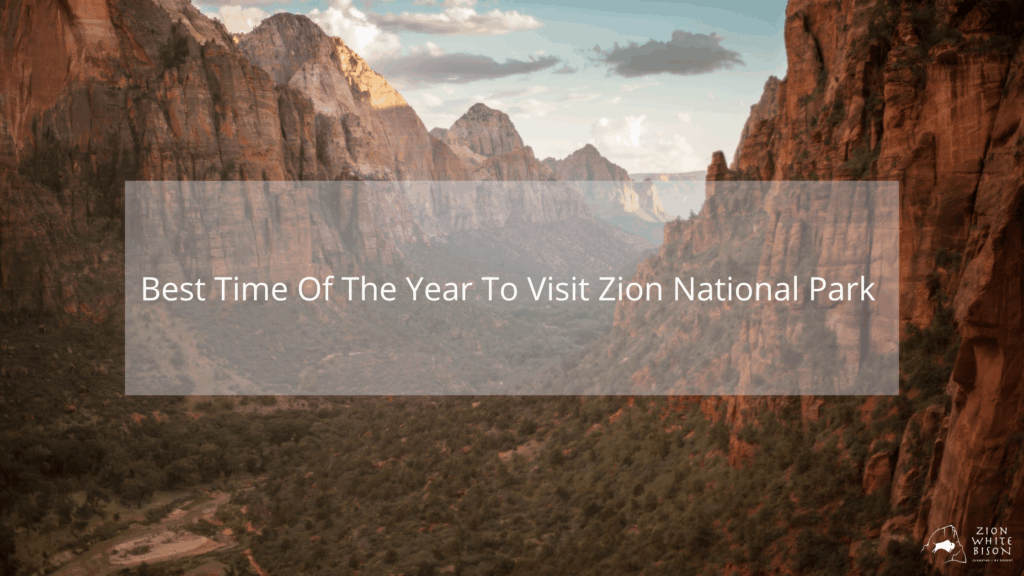Discovering the Best Time of Year to Visit Zion National Park.
Zion National Park, located in southwestern Utah, is a breathtakingly beautiful natural destination that attracts millions of visitors each year. From its towering red cliffs and sandstone spires to its deep canyons and waterfalls, Zion is a true wonder of the natural world. When it comes to deciding on the best time to visit Zion National Park, there are a few factors to consider. These include weather, crowd levels, and which activities you want to participate in. Let’s take a closer look at each of these factors to determine the best time of year to visit Zion.
Weather:
- Spring: March to May As winter’s grasp loosens, spring arrives, bringing renewed life to Zion National Park. With average temperatures ranging from 50°F to 80°F (10°C to 26°C), this season offers pleasant weather for outdoor activities. The melting snow feeds the park’s waterfalls, creating stunning cascades that add to the park’s allure. Springtime is also perfect for witnessing the vibrant bloom of wildflowers, turning the park into a kaleidoscope of colors. Popular activities during this season include hiking The Narrows, exploring the Zion Canyon Scenic Drive, and photographing the iconic Weeping Rock.
- Summer: June to August Summer at Zion National Park is characterized by hot temperatures and a surge in visitor numbers. With average temperatures ranging from 80°F to 100°F (26°C to 38°C), it’s essential to stay hydrated and take precautions against the sun. Early mornings and late evenings are ideal for outdoor activities to avoid the peak heat of the day. During this season, you can explore the diverse hiking trails, such as Angels Landing or Observation Point, or try canyoneering in The Subway or Mystery Canyon. Additionally, summer offers the chance to witness awe-inspiring thunderstorms and experience the beauty of the park in the evening glow.
- Fall: September to November Fall is considered by many as the best time to visit Zion National Park. As temperatures begin to cool down, ranging from 60°F to 80°F (15°C to 26°C), the park undergoes a stunning transformation. The foliage changes to vibrant shades of red, orange, and yellow, creating a picturesque backdrop for outdoor activities. Fall is perfect for hiking, as the trails are less crowded. Popular hikes during this season include the challenging but rewarding West Rim Trail and the picturesque Emerald Pools. Fall also offers a chance to witness the mesmerizing mating displays of the park’s wildlife, including bighorn sheep and mule deer.
- Winter: December to February Winter transforms Zion National Park into a tranquil wonderland. While snowfall is intermittent, temperatures can range from 30°F to 50°F (-1°C to 10°C) with most days in the low 60’s. Exploring the park during winter offers a unique experience, with fewer visitors and a serene atmosphere. The lower elevation trails are typically accessible, and the striking contrast of red rocks against snow-covered landscapes provides stunning photo opportunities. Winter activities at Zion include hiking the Riverside Walk, observing the ice formations in the Narrows, and embarking on scenic drives along the Zion-Mount Carmel Highway. Even though the park might be colder at this time of the year Zion White Bison is just below the park and has amazing weather year-round. each unit has heat and personal fire pits making it a favorite time of the year to visit for many of our guests.
- General Weather Considerations Understanding the general weather patterns at Zion National Park is crucial for planning a successful visit. It’s important to note that weather conditions can vary, and it’s always recommended to check the forecast before your trip. The park’s lower elevations generally experience hotter temperatures, while higher elevations tend to be cooler. Thunderstorms are common during summer, so be prepared with rain gear and monitoring weather updates is essential. Additionally, flash floods are a potential hazard in slot canyons, so always heed the park’s safety warnings and guidelines.
Crowd Levels:
Zion National Park is a popular destination, and as such, it can get quite crowded during peak season. The busiest times to visit the park are during the summer months when school is out and families are on vacation. If you want to avoid the crowds, it is best to visit during the fall or spring, when the park is less crowded.
Activities:
The type of activities you want to participate in can also impact the best time to visit Zion National Park. If you are interested in hiking, the cooler months of fall and spring are the best times to visit. The summer months can be too hot for extended periods of outdoor activity, and the winter months may not offer the best hiking conditions due to snow and ice.
If you are interested in photography, the fall and spring offer the most beautiful lighting conditions and the most colorful landscapes. The fall is especially beautiful, with the trees turning golden and red and the park ablaze with color.
The winter months can offer some unique opportunities for photography, with the park blanketed in snow and ice. If you are interested in capturing the beauty of the park in a different light, the winter may be the best time for you to visit.
In conclusion, the best time to visit Zion National Park depends on your personal preferences and the type of activities you want to participate in. If you want to avoid the crowds and enjoy cooler temperatures, the fall and spring are the best times to visit. If you are interested in photography, the fall and spring offer the most beautiful lighting and colorful landscapes. And if you want to experience the park in a different light, the winter months may be the best time for you to visit. No matter when you decide to go, Zion National Park is a truly breathtaking destination that is sure to leave a lasting impression.

